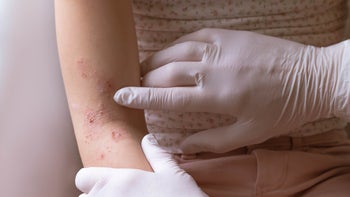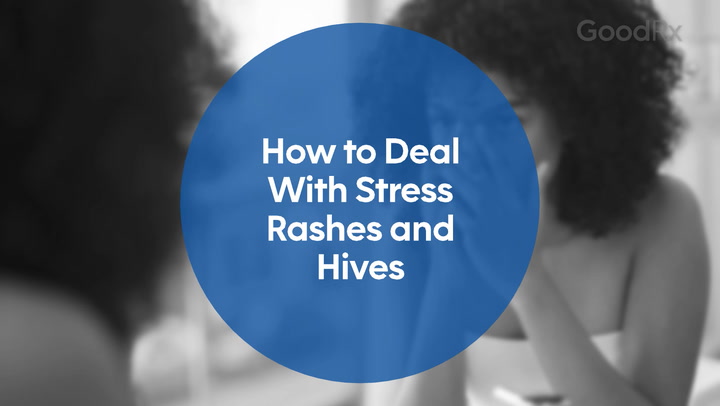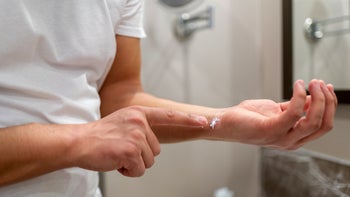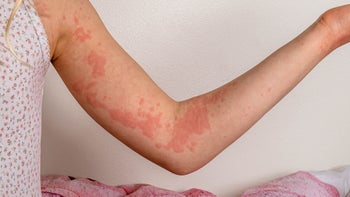
7 Ways to Get Rid of Hives Quickly
Key takeaways:
Antihistamines are usually the best medication for hives. Newer antihistamines — like cetirizine, loratadine, and fexofenadine — are safer than diphenhydramine (Benadryl). And they’re equally effective at reducing itching and redness.
Cool compresses, calamine lotion, and oatmeal baths are medication-free ways to treat hives quickly.
Hives usually go away on their own. But get medical care if you have signs of a severe allergic reaction, or over-the-counter medications aren’t helping.

Hives, also called urticaria, show up as itchy, red bumps on the skin. Hives can happen due to an allergic reaction to food, medication, pollen, or pet dander. Or they can be triggered by insect bites, exposure to heat or cold, or an infection. In some cases, the trigger isn’t clear.
Most of the time hives will go away on their own. But while you have them, hives can be very uncomfortable and itchy. Fortunately, there are things you can do at home to treat hives. Let’s review ways to get rid of hives quickly.
1. Cool compress
A cool compress is a quick way to relieve itching from hives. Lowering the temperature of the skin can help bring down swelling and reduce the itching sensation, at least temporarily.
Search and compare options
To make a cool compress, run a washcloth under cold water or wrap an ice pack in a towel. Apply the compress for 10 to 15 minutes at a time. But, if you think your hives are triggered by the cold, skip the cool compress, since this could aggravate your symptoms.
If hives cover a large area of your body, try taking a cool shower instead.
2. Aloe vera
Many people use aloe vera gel to help soothe sunburned skin. In addition to relieving itching from minor burns, there’s some evidence that aloe vera may help people with other skin conditions. That’s because aloe vera has anti-inflammatory properties and helps hydrate the skin.
To reduce itching from hives, try applying a thin layer of aloe vera gel. Be sure to test it out on a small area of skin first. Though it’s rare, people can have an allergic reaction to aloe vera.
3. Diphenhydramine (Benadryl)
Histamines are chemicals that make your skin become red and itchy when you have hives. Diphenhydramine (Benadryl) is an antihistamine. It works by blocking histamines. Benadryl usually comes as a pill or liquid taken by mouth. It’s also available as a cream that can be applied directly to the skin. But there isn’t much evidence that the cream helps reduce itching.
This medication can cause side effects, like drowsiness, dizziness, and blurred vision. It can also increase the risk of falls in older adults. That’s why it’s important to take the correct dose of Benadryl, and only use it when you have time to stay home and rest.
4. Other types of antihistamines
If you’re looking for an antihistamine for hives that won’t make you drowsy, try cetirizine (Zyrtec), loratadine (Claritin), or fexofenadine (Allegra). These are newer over-the-counter (OTC) medications, called second-generation antihistamines. They’re available as capsules and tablets, disintegrating tablets, and liquids.
Unlike Benadryl, second-generation antihistamines don’t cross from the bloodstream into the brain, so they’re less likely to cause side effects, like sleepiness and fatigue. And studies have shown they work as well as Benadryl for treating hives. That’s why experts often recommend them for treating hives.
5. Hydrocortisone cream
Hydrocortisone is an OTC steroid cream that can be used on itchy skin. It decreases inflammation and has been shown to reduce itching for people with eczema and psoriasis. It’s not clear how effective it is at treating itching caused by other skin conditions, like hives.
Hydrocortisone cream can be applied 1 to 4 times per day, for up to 2 weeks. Long-term use of steroid creams can lead to side effects, like redness or skin thinning. So, talk to your primary care provider if your hives aren’t improving with hydrocortisone cream.
6. Calamine lotion
This distinctive pink liquid is made of zinc oxide and iron oxide which soothes and protects skin. There’s not much research on using calamine lotion to treat hives, but it has been shown to reduce itching from insect bites or poison ivy. So, it’s a safe OTC anti-itch treatment to try at home. Calamine lotion can dry out the skin, but otherwise most people don’t have side effects.
7. Oatmeal baths
Oatmeal baths have been used to treat skin conditions for centuries — and there’s scientific evidence that it works. Colloidal oatmeal has antioxidant and anti-inflammatory properties.
To make your own oatmeal bath at home, follow these steps:
Grind 1 cup of oats in a blender or food processor.
Place the ground oats in a bathtub filled with lukewarm water.
Soak in it for at least 10 to 15 minutes.
When should you seek medical care for hives?
Severe allergic reaction (anaphylaxis) is a life-threatening condition that needs emergency treatment. Get immediate medical care for hives if you have signs of anaphylaxis, including:
Swollen lips
Swollen tongue
Throat tightness
Difficulty breathing
Vomiting
Diarrhea
Feeling faint
If your hives aren’t getting better with home treatments — or if you’re unsure whether hives or something else caused your rash — talk to a healthcare professional. They may recommend a prescription medication or additional testing if the diagnosis is unclear.
The bottom line
Hives will usually go away on their own. You can help get rid of hives quickly with a combination of OTC medications and home remedies. Medications like cetirizine, loratadine, and fexofenadine are the best antihistamines for hives. They work as well as diphenhydramine (like Benadryl) to relieve itching, without causing drowsiness. They can be used in combination with topical treatments, like oatmeal baths, aloe vera, and cool compresses.
Why trust our experts?



References
American Academy of Dermatology Association. (n.d.). 10 ways to get relief from chronic hives.
American Academy of Dermatology Association. (n.d.). How to relieve itchy skin.
American Academy of Dermatology Association. (n.d.). Poison ivy, oak, and sumac: How to treat the rash.
Craun, K. L., et al. (2022). Fexofenadine. StatPearls.
Dal'Belo, S. E., et al. (2006). Moisturizing effect of cosmetic formulations containing aloe vera extract in different concentrations assessed by skin bioengineering techniques. Skin Research and Technology.
Eschler, D. C., et al. (2010). An evidence-based review of the efficacy of topical antihistamines in the relief of pruritus. Journal of Drugs in Dermatology.
Feily, A., et al. (2009). Aloe vera in dermatology: A brief review. Giornale Italiano di Dermatologia e Venereologia.
Fein, M. N., et al. (2019). CSACI position statement: Newer generation H1-antihistamines are safer than first-generation H1-antihistamines and should be the first-line antihistamines for the treatment of allergic rhinitis and urticaria. Allergy, Asthma, and Clinical Immunology.
Powers, J., et al. (2023). Insect bites. StatPearls.
Maddin, S. (1997). Efficacy and safety of antihistamines in allergic skin disorders. Journal of the European Academy of Dermatology and Venereology.
Mahboub, M., et al. (2021). A comparative study of the impacts of aloe vera gel and silver sulfadiazine cream 1% on healing, itching and pain of burn wounds: A randomized clinical trial. Journal of Caring Sciences.
MedlinePlus. (2018). Hydrocortisone topical.
Naqvi, A., et al. (2023). Cetirizine. StatPearls.
Peng, X., et al. (2021). Aloe vera and the skin. DermNet.
Purnamawati, S., et al. (2017). The role of moisturizers in addressing various kinds of dermatitis: A review. Clinical Medicine & Research.
Reynertson, K. A., et al. (2015). Anti-inflammatory activities of colloidal oatmeal (Avena sativa) contribute to the effectiveness of oats in treatment of itch associated with dry, irritated skin. Journal of Drugs in Dermatology.
Sidhu, G., et al. (2023). Loratadine. StatPearls.
Stacey, S. K., et al. (2021). Topical corticosteroids: Choice and application. American Family Physician.
Wolfson, A. R., et al. (2022). Diphenhydramine: Time to move on? Journal of Allergy and Clinical Immunology: In Practice.
Yarbrough, K. B., et al. (2013). The effects of treatment on itch in atopic dermatitis. Dermatologic Therapy.

















